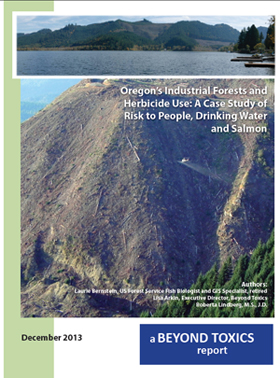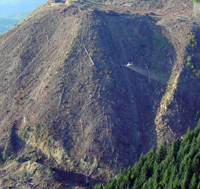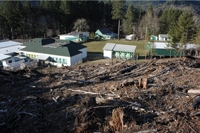 "Oregon’s Industrial Forests and Herbicide Use: A Case Study of Risk to People, Drinking Water and Salmon"
"Oregon’s Industrial Forests and Herbicide Use: A Case Study of Risk to People, Drinking Water and Salmon"
Authors:
Laurie Bernstein, US Forest Service Fish Biologist and GIS Specialist, retired
Lisa Arkin, Executive Director, Beyond Toxics
Roberta Lindberg, M.S., J.D.
Download Report (2 versions; both PDF files)
- EXECUTIVE SUMMARY (PDF)
- FULL REPORT (15Mb PDF; opens in new browser window)
- Press Release
- Fact Sheet (2 page PDF)
Issue Background
The issue of rural community health and exposure to forestry pesticides in air and drinking water has never been more important. Polling by the Pew Research Center consistently shows that clean water is what matters most to Oregonians.
However, Oregon’s loose and antiquated forestry laws permit the use of herbicides aerially sprayed by helicopter. That’s different from federal logging practices, which banned the use of aerial helicopter spray over twenty years ago.
Beyond Toxics compiled the first in-depth analysis of private, industrial forestry pesticide application records in the State of Oregon. Oregon’s Industrial Forests and Herbicide Use: A Case Study of Risk to People, Drinking Water and Salmon, uses GIS mapping and quantitative measurements to document and discuss primary concerns with the state’s Oregon Forest Practices Act. The data is derived from pesticide spray records obtained from the Highway 36 Corridor Public Health Exposure Investigation. The geographic scope is limited because the Oregon Department of Forestry does not have forestry spray records from any other area in the entire state.
The report is eye-opening on several levels. First, there are known endocrine disrupting chemicals entering our drinking water sources and fish-bearing streams. Secondly, Oregon does not require a no-spray buffer near homes and schools. Also, aerial herbicide sprays regularly occur directly over headwaters and tributaries of protected salmon streams. Oregon permits pesticides to be sprayed with only the smallest protective buffer of 60 feet from salmon and steelhead streams. This buffer is significantly smaller than other Northwest states with similar forest and river ecosystems.
The report also shows that Oregon’s pesticide spray regulations are insufficient compared to Washington and Idaho. Interestingly, the same timber companies operating in Oregon, and claiming that they must have lax environmental protections to profit, own and log forestland in neighboring states requiring more protective regulations. For example, Weyerhaeuser, with its corporate headquarters in Washington, follows stricter chemical rules as required in that state.
Under the current administrative rules, the Oregon Forest Practices Act prohibits researchers, doctors and the public from obtaining accurate information about what types and quantities of herbicides are sprayed. Lack of information prevents timely treatment of pesticide poisoning cases and accurate scientific research.
The report concludes with specific recommendations for modernizing Oregon’s Forest Practices Act. A key recommendation is to simply update Oregon’s rules to match the standards of Washington state, rules that are crafted on science and sensible environmental protections.
Resources
Photos for Download (R-click on links below and choose "Save Image As")
 Triangle Lake in the Siuslaw Watershed. Photograph by Gary Hale.
Triangle Lake in the Siuslaw Watershed. Photograph by Gary Hale.
PRINT resolution (.jpg; RGB; 4 Mb) | SCREEN resolution (.jpg; RGB; 800x200 px - 140K)
 Helicopter spraying herbicides on Seneca clearcut. Photograph by Francis Eatherington.
Helicopter spraying herbicides on Seneca clearcut. Photograph by Francis Eatherington.
PRINT resolution (.jpg; RGB; 4 Mb) | SCREEN resolution (.jpg; RGB; 800x754 px - 700K)
 Triangle Lake School surrounded by clear cut
Triangle Lake School surrounded by clear cut
PRINT resolution (.jpg; RGB; 970K) | SCREEN resolution (.jpg; RGB; 600x400 px - 140K)
Stories of Chemical Trespass
"Poisoned Roads"
The story of how rural residents of northern Klamath County were doused with a deadly pesticide in 2010. Produced by Lisa Arkin and Douglas McGowan.
Helen Hollyer (Helen lives near Creswell, OR in the Willamette Valley)
Stories of Chemical Trespass: Orville and Mary Camp (Orville and Mary live near Selma, OR in the Illinois Valley)

